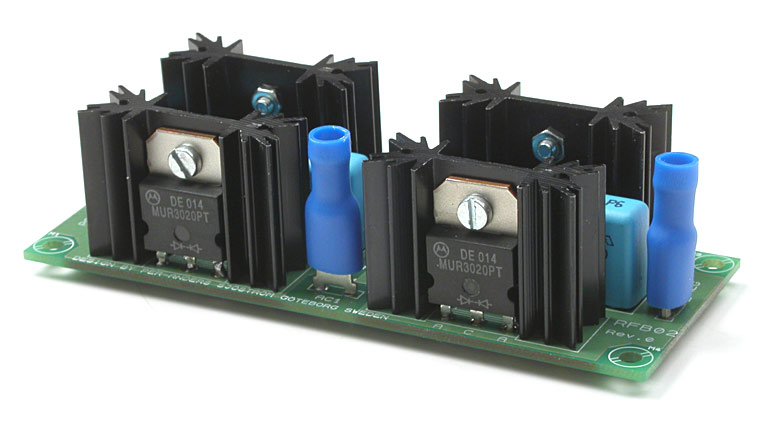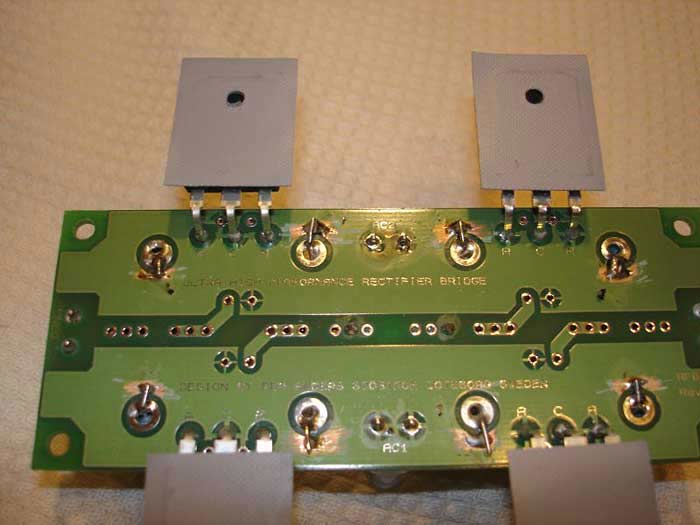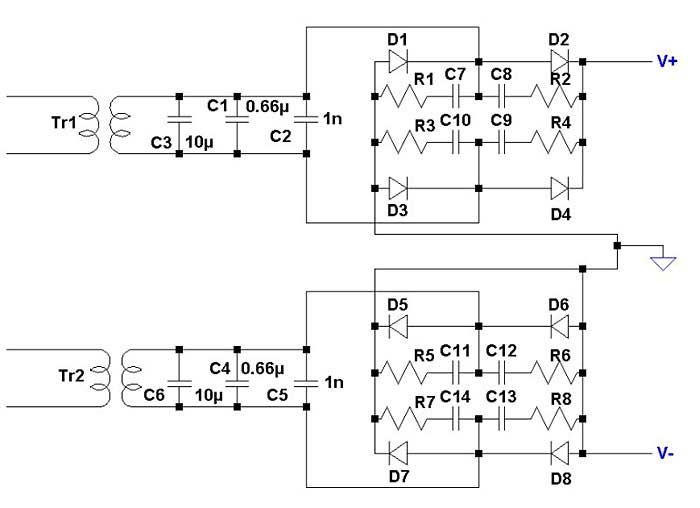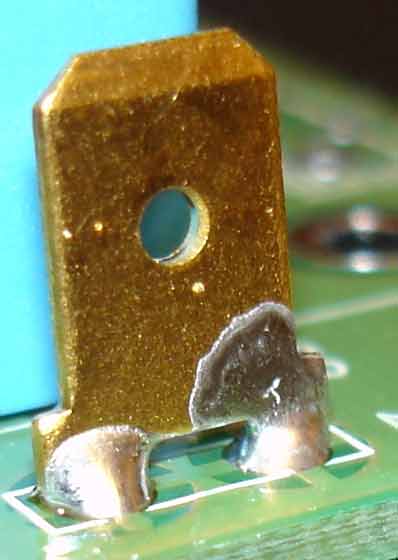How to change the RFB02, RFB03 rectifier bridge into heavy duty

Tweaking the RFB-02 rectifier bridge
The high-end designer Sigurd Ruschkowski has thought a bit how to tweak the RFB02 rectifier bridge into higher levels of performance. The instructions is also valid for the RFB03. If you wonder about anything, please ask Mr. Ruschkowski.
RFB-02s in dual bridge setup and with AC filter capacitors
Foreword
I have about 16 of the RFB-02 and am very happy with them! I have put them to good use in my preamp and in my power amp. For my preamp I use 2+2 RFB-02s for a dual mono setup and double rectifying use, i.e. 2 rectifier bridges per channel. No heat sink needed of course. For my power amp I also use 2 rectifier bridges per channel. In total 16 diodes. They are mounted on two “fat” heat sinks.
The RFB-02s are very versatile! They can be assembled with or without snubbers around each diode, but that is not all. I have found a way to mount filter capacitors on the RFB-02. These capacitors filter out RF noise from the transformer AC voltages
I will describe what I have done to the RFB-02 so one can mount filter capacitors on them.
Drill Template
First, however, I will show the drill template I have made which makes it easy to drill the holes for the four mounting holes (M3).

Figure 1 Drilling template for RFB-02

Figure 2 Schematics showing the capacitors on the AC voltages.
Figure 2 shows the schematic of how I filter out noise. As you can see I use two rectifier bridges for each the positive and the negative power supply voltage. I believe this is the best way to rectify AC voltages into power supply voltages for high end amplifiers.
I use X2 capacitors for C3 and C6. They are rated 300 VAC and made for this application. C3 is used to take out low frequency noise and C6 will take out most high frequency noise. C12 is a standard polypropylene rated 100 VDC.
RFB-02 for the power amp
The diodes for a power amp needs to be mounted on some kind of heat sink. It is not much space in my power amp so I figured that an assembly of one RFB-02 on each side of a Al plate would be good idea. As I wanted to be able to screw PCB stand-offs into the Al heat sink it needed to be thick. I used a 15mm solid Al plate and mounted 4 IXYS (60A, 200 V) Schottky diodes on each side of the plate. I made four 2.2 mm holes using the drill template I made. These holes go all the way through the Al plate. Then I threaded these 2.2 mm holes. Beware, that you should not make the threading go all the way through the hole from only one side as you will then not be able to screw standard screws into the 4 counter threaded holes on one side! One has to make the threads first for one side (around 6 mm deep) and then make the threads for the other side from the other side.
The diodes are mounted in pairs, that is I made only one hole (without threading them) for each pair of diodes. A long M3 screw then finishes the diode fastening. Isolation washers made out of silicone were used for short circuit prevention.
As I used Schottky diodes the snubbers are not necessary. These types of diodes do not have any recovery problems as other diodes have. I think that snubbers on Schottky diodes can even make things worse by introducing ringing.

Figure 3 Power amp rectifiers. Snubbers not used. Plenty of space on the PCB. This space will be used for the AC filter capacitors.

Figure 4 Another view shows the dual RFB-02s. Note the right spade plug. It is a dual one which will be used to make the ground connection.
The assembly looks rather nice, and the share weight of it makes it feel good! The mass of the Al plate is of course not necessary for cooling purposes. The heat sink plate area is the most important thing when it comes to cooling the diodes.
It is made for a power amp, and this bridge of mine really fits well into a huge power amp like I have .
Now, where to fit the four capacitors for AC filtering and one for DC filtering? A look at figure 5 shows that there is plenty of space where the four pair of snubbers and four heat sinks usually are to be fitted.

Figure 5 Stuffing guide for RFB-02.
To be able to solder the four X2 capacitors, one has first to scrape off some green laquer around the holes for KF1-KF4 (intended use for diode heat sinks) so there is some bare copper to solder onto. The holes for KF1-4 are used for the X2 capacitors!

Figure 6 The PCB has been scraped and the extra capacitors are soldered.

Figure 7 The four X2 capacitors and the DC voltage filtering capacitor are mounted. The PCB is now finished.
Figure 7 shows how well the larger X2 capacitors fit into the holes for KF1-4. The smaller (10nF) capacitors do not fit as well as the larger ones, but it was easy to fit them anyway. The PCB is now finished. It is a heck of a rectifier/filtering unit!
RFB-02 for the pre amp
Here is my "low current" version of a double rectifier unit built on the RFB02's. It can handle an amp or so without any heat sinks. This time with ONsemi fast recovery diodes (FRED's), MRS820, soft recovery diodes.
In my oppionion only Schottky diodes can do without snubbers. Therefore, I have used snubbers for each of the 8 diodes used in this dual low-noise rectifying bridge. The schematic is shown in figure 13. If you compare this schematic to the one for the power amp, I have added one more capacitor to filter the AC voltages even better. This is because a low noise power supply is more important the lower the signals are.

Figure 13 Schematic of the dual, low-noise rectifying bridge for my pre amp.
The capacitors on the DC voltages did not fit on the PCB, so I have put them together with the big electrolytics instead. If you are a bit handy, you can surely find a way to fit these capacitors on the PCB, too.

Figure 8 Here, the snubbers are mounted on the PCB. Note that I have used golden spade connectors.

Figure 9 Soldering tin flows far better on the golden spade connectors compared to plain tinned ones.
Assembly is shown in figure 10 and 11. Note that there is a short wire between the two PCBs. This wire creates the virtual ground between the two rectifying bridges. See also the schematic.
To be able to mount solder the three capacitors on the AC voltage, you need to scrape off some green laquer first. I usually presolder this bare copper surface before I solder the legs on the capacitors. This is because the copper surface is very, very large and one needs to heat the copper a comparatively long time. When presoldering is done, soldering the legs is a small task.

Figure 10 Assembly.

Figure 11 Assembly. PCB is now finished.
This ends this article about filtering out noise on the transformer seconodaries on Per-Anders Sjöström's RFB02 (replaced by RFB03) rectifying designs, and how I how assembled two different dual rectifying bridges. One for a power amp with Schottky diodes, and another for a pre amp using soft recovery FREDs.
